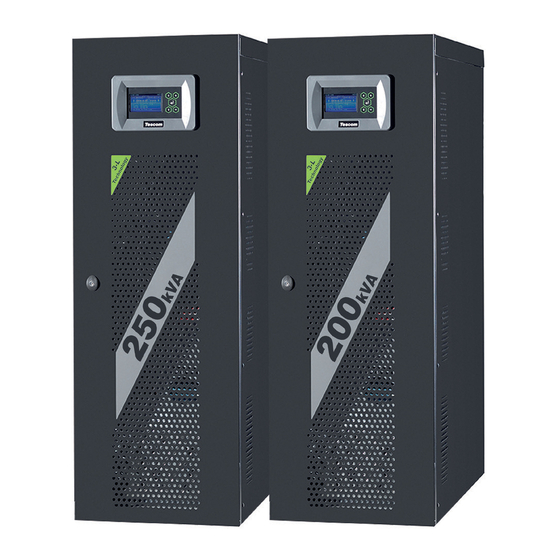
Summarization of Contents
GENERAL DESCRIPTION
Introduction
Overview of TESCOM DX3000 Series double-conversion, 3-level on-line UPS units.
Design Concept
Explanation of the UPS architecture, including rectifier, inverter, and bypass functions.
DESCRIPTION OF BLOCKS
Detailed description of the rectifier, batteries, inverter, static, and maintenance bypass blocks.
OPERATING CONDITIONS OF UPS
Outlines normal, battery, and bypass operating modes of the UPS system.
UPS Connection Panel View
Visual guide to the front panel UPS connection terminals and interfaces.
Technical Specifications
Comprehensive list of electrical, environmental, and physical specifications for DX3000 series.
SAFETY
Important Safety Notices
Critical instructions and warnings for safe installation and operation of the UPS unit.
WARNING!
Safety warnings regarding ventilation, environment, and fuse replacement.
CAUTION!
Safety precautions for qualified personnel, electric shock risks, and unit placement.
Battery Safety Precautions
Information on battery risks, handling, disposal, and safety precautions.
UPS INSTALLATION
Introduction and Preparation
Introduction, unpacking, and equipment positioning guidelines.
Power Cable Connections
Connecting power cables, safety earth, and cable procedures.
External Battery Installation
Instructions for safely installing and connecting external battery groups.
FRONT PANEL
Introduction and Overview
Overview of the UPS front panel interface, screen, and keys.
Menu Navigation and Operations
How to use the front panel menus for measurements, alarms, options, commands, etc.
Alarms, Status Codes, and Troubleshooting
Understanding and resolving alarm messages, status codes, and common issues.
OPERATING INSTRUCTIONS
INTRODUCTION
General preparation before operating the UPS, including electrical connections.
Online Mode Operation
Step-by-step guide for starting and shutting down the UPS in online mode.
Starting Up from Shutdown
Procedure to safely start the UPS from a fully powered-off state.
Shutting Down the UPS
Steps for properly powering down the UPS and its critical loads.
Switch to Maintenance Bypass
Instructions to safely switch the UPS to maintenance bypass mode.
Return from Maintenance Bypass
Procedure to return the UPS from maintenance bypass to normal online operation.
Mains Outage Behavior
How the UPS operates and responds during mains power failures and battery operation.
PARALLEL OPERATION
Introduction
Reasons and benefits of connecting multiple UPS units in parallel for redundancy or capacity.
Parallel Mode Configuration
Configuration parameters for enabling and setting up parallel UPS operation.
Parallel Mode Status Codes
Explains status codes related to parallel UPS system faults and communication issues.
PARALLEL OPERATING INSTRUCTIONS
INTRODUCTION
Preparation steps for parallel UPS operation, checking connections.
Parallel UPS Operation Procedures
Procedures for starting, shutting down, and switching UPSs in a parallel configuration.
Starting Parallel UPSs
Steps to start multiple UPS units operating in parallel.
Shutting Down Parallel UPSs
Procedures for safely shutting down UPS units in a parallel setup.
Parallel to Maintenance Bypass
How to move parallel UPS units to maintenance bypass mode.
Parallel Return from Maintenance Bypass
Returning parallel UPS units from maintenance bypass to normal operation.
UPS Maintenance
Scheduled Maintenance Tasks
Overview of periodic maintenance tasks required for UPS and battery health.
Daily UPS Checks
Routine checks to perform daily to ensure UPS normal operation.
Weekly UPS Checks
Recommended checks to be performed weekly for UPS maintenance.
Annual Maintenance (Service)
Requirements for annual maintenance performed by authorized service personnel.
Storage and Transportation
Guidelines for proper storage and safe transportation of UPS units and batteries.
Faults and Troubleshooting
Fault Diagnosis Procedure
Systematic approach to identifying and resolving UPS faults and errors.
Pre-Service Checklist
Checklist of items to verify before contacting technical support for assistance.
Remote Monitoring and Control
Serial Port Communication
Using serial ports and cables for UPS monitoring and control.
Modem Remote Access
Setting up modem connection for remote UPS monitoring and control.
Interface and Panel Connections
Using dry contacts and remote panels for monitoring and control.













Need help?
Do you have a question about the DX3100 and is the answer not in the manual?
Questions and answers